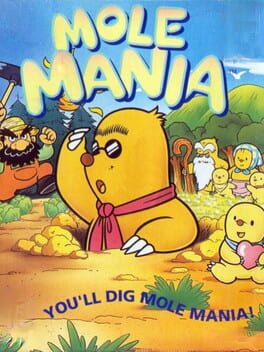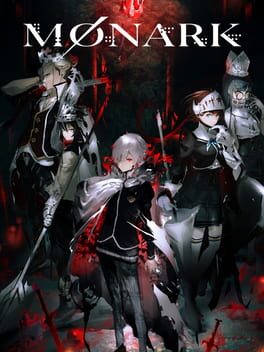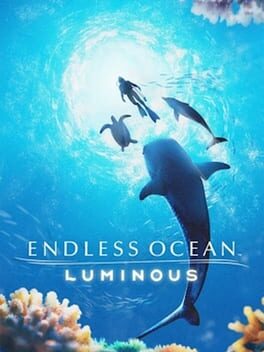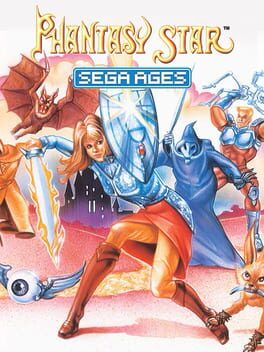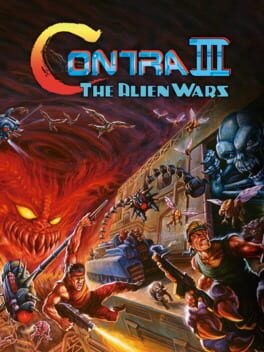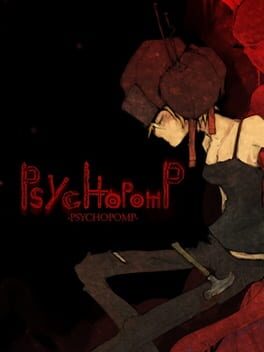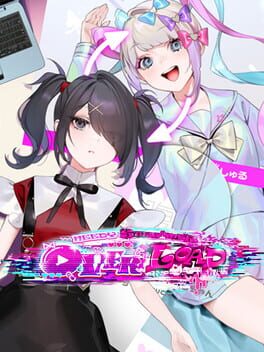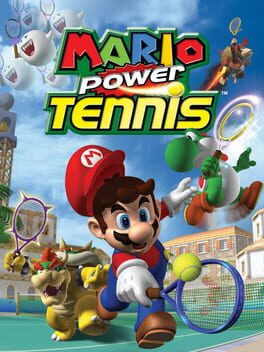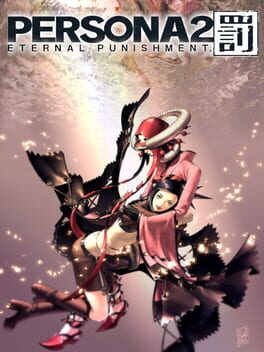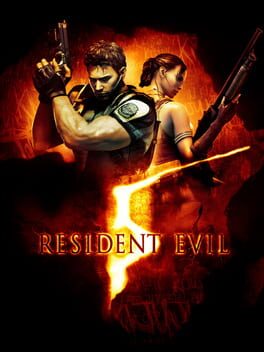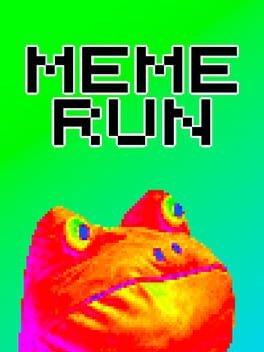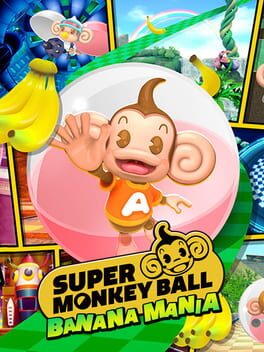mystgourmet
57 Reviews liked by mystgourmet
Mole Mania
1996
Known as "Moguranya" in Japanese (a portmanteau of the Japanese word for "mole" and the English word "mania", and also oddly enough the name of the main character in the Japanese version), this is a game that's been recommended to me for years, but I only just got around to finally giving it a go. I recently picked up a GameCube and a GameBoy Player, so I finally have a way to play GameBoy games again. I also found a copy of this for 300 whole yen at the resale place where I picked up my GameCube and such, so it was an easy choice to pick it up. Unfortunately, the save battery was dead, so I had to beat it in one sitting, but I probably would've beaten it in one sitting anyway because of how addicting it is X3. I 100%'d the Japanese version of the game over the course of a little over 6 hours.
The game stars the main character Moguranya in a quest to save his family. The game opens with the cabbage farmer Jinbe angry that the moles keep stealing his cabbages, so he takes things into his own hands and kidnaps Moguranya's whole heckin' family, all seven children and his wife, and leaves Moguranya a taunting note daring him to try to get them back. Being a loving father, Moguranya of course immediately sets out on a quest to rescue his family and teach Jinbe a lesson. It's a fairly light story, but there's quite a bit of fun, silly dialogue given to you via signs in each level written by both the bosses of that world as well as from the elderly mole who serves as your tutorial giver as well as checkpoint bearer. There are also fun little vignettes of Moguranya and his rescued kids every time you beat a world (very much like older Kirby games have), which add to the silly fun of it all.
But the real meat here is the gameplay, and the gameplay that's here is basically a Sokoban game (warehouse block pushing), but probably the most fun version of that I've ever played (especially granted it's a genre I don't generally enjoy). The game has seven worlds (with world 8 just being a boss rush) of many rooms each, and the goal of each room is to get a boulder to the rock wall at the end to break it and allow you to progress to the next room. There are also 20 cabbages in each level to collect by rolling them into a hole, as well as a map, radar, and time trial mini-game against Jinbe which also add to the score you get at the end of each stage (although 100%-ing the game doesn't actually do anything, so far as I can tell).
What sets this apart from other Sokoban games isn't just the very forgiving difficulty, but the fact that it not only auto-saves after every room you complete (probably why the save battery in mine is dead ^^;), but it also has unlimited lives and you respawn at the start of a room just as you entered it. While there are enemies and tough, well-designed bosses, getting killed at the action parts will never send you way-way back, and they're just as much a part of the puzzles as the walls and boulders are. You also have a large degree of control as to how you manipulate the boulders, cabbages, and other obstacles you'll encounter. You can push them, pull them, and also launch them forward and behind you by flipping them over yourself. This means that while it may be possible to make a room unsolveable so you need to backtrack a room to reset it, you'll never get stuck or have to redo large swaths of content like so many other Sokoban games. You're also a mole, so naturally you can dig too, giving every room two layers to consider in your goal to solve the puzzle therein. The level design is really well done, and although the difficulty curve is a bit up and down in a weird way at times, it always feels so satisfying when you finally solve the room.
That difficulty curve issue, if you can even call it that, is really the only major issue the game has, if you can really call it that. There's a weird feeling to having one room that takes you some 15 minutes to finally wrap your head around and complete, and then have it followed by several that you almost instantly figure out, but it's not really a bad thing. Though this game does suffer from that Lemmings-style of "okay, I know what to do, now I just gotta DO it" that many action-puzzle games suffer from. The game should also really heal you whenever you complete a room, as there are heal rooms run by the elderly mole, so you can just backtrack through safe, completed rooms to get healed when you're really hurt, and it doesn't really make much sense not to just heal you every time you win a room. But again, these are really small complaints.
The presentation is also really what you'd expect from a first-party Nintendo game. It may only be a GameBoy game, but the sprite work is really excellent, as are the animations. It looked really nice even on a big TV~. The music is also very good, and has a very Kirby-like feel to it (despite not being a game made by HAL).
Verdict: Highly Recommended. I'm definitely not the first person to recommend people play Mole Mania, and I highly doubt I'll be the last. It's an excellent puzzle game with a super addictive "just one more room!" feel to it that is never consistently soul-crushingly hard. It's not a super hard physical game to find, and it's also on the 3DS Virtual Console, so this is a pretty easy game to pick up legit too. If you're a fan of puzzle games, this is absolutely not a game to sleep on~
The game stars the main character Moguranya in a quest to save his family. The game opens with the cabbage farmer Jinbe angry that the moles keep stealing his cabbages, so he takes things into his own hands and kidnaps Moguranya's whole heckin' family, all seven children and his wife, and leaves Moguranya a taunting note daring him to try to get them back. Being a loving father, Moguranya of course immediately sets out on a quest to rescue his family and teach Jinbe a lesson. It's a fairly light story, but there's quite a bit of fun, silly dialogue given to you via signs in each level written by both the bosses of that world as well as from the elderly mole who serves as your tutorial giver as well as checkpoint bearer. There are also fun little vignettes of Moguranya and his rescued kids every time you beat a world (very much like older Kirby games have), which add to the silly fun of it all.
But the real meat here is the gameplay, and the gameplay that's here is basically a Sokoban game (warehouse block pushing), but probably the most fun version of that I've ever played (especially granted it's a genre I don't generally enjoy). The game has seven worlds (with world 8 just being a boss rush) of many rooms each, and the goal of each room is to get a boulder to the rock wall at the end to break it and allow you to progress to the next room. There are also 20 cabbages in each level to collect by rolling them into a hole, as well as a map, radar, and time trial mini-game against Jinbe which also add to the score you get at the end of each stage (although 100%-ing the game doesn't actually do anything, so far as I can tell).
What sets this apart from other Sokoban games isn't just the very forgiving difficulty, but the fact that it not only auto-saves after every room you complete (probably why the save battery in mine is dead ^^;), but it also has unlimited lives and you respawn at the start of a room just as you entered it. While there are enemies and tough, well-designed bosses, getting killed at the action parts will never send you way-way back, and they're just as much a part of the puzzles as the walls and boulders are. You also have a large degree of control as to how you manipulate the boulders, cabbages, and other obstacles you'll encounter. You can push them, pull them, and also launch them forward and behind you by flipping them over yourself. This means that while it may be possible to make a room unsolveable so you need to backtrack a room to reset it, you'll never get stuck or have to redo large swaths of content like so many other Sokoban games. You're also a mole, so naturally you can dig too, giving every room two layers to consider in your goal to solve the puzzle therein. The level design is really well done, and although the difficulty curve is a bit up and down in a weird way at times, it always feels so satisfying when you finally solve the room.
That difficulty curve issue, if you can even call it that, is really the only major issue the game has, if you can really call it that. There's a weird feeling to having one room that takes you some 15 minutes to finally wrap your head around and complete, and then have it followed by several that you almost instantly figure out, but it's not really a bad thing. Though this game does suffer from that Lemmings-style of "okay, I know what to do, now I just gotta DO it" that many action-puzzle games suffer from. The game should also really heal you whenever you complete a room, as there are heal rooms run by the elderly mole, so you can just backtrack through safe, completed rooms to get healed when you're really hurt, and it doesn't really make much sense not to just heal you every time you win a room. But again, these are really small complaints.
The presentation is also really what you'd expect from a first-party Nintendo game. It may only be a GameBoy game, but the sprite work is really excellent, as are the animations. It looked really nice even on a big TV~. The music is also very good, and has a very Kirby-like feel to it (despite not being a game made by HAL).
Verdict: Highly Recommended. I'm definitely not the first person to recommend people play Mole Mania, and I highly doubt I'll be the last. It's an excellent puzzle game with a super addictive "just one more room!" feel to it that is never consistently soul-crushingly hard. It's not a super hard physical game to find, and it's also on the 3DS Virtual Console, so this is a pretty easy game to pick up legit too. If you're a fan of puzzle games, this is absolutely not a game to sleep on~
Monark
2021
It's been many years since I've played Endless Ocean/Forever Blue on Wii, so I was looking forward to this. It was fun at first. Then I did several more solo dives to make slow progress through the story. Something felt... off. So, I went back and... well, my memory was right.
Swimming around freely and looking at sea creatures will never not be a good time, but this is unfortunately quite barebones compared to Forever Blue 1 (can't speak for 2 as I haven't played it yet).
Just looking at it, it looks worse than on Wii. The UI is basic and bland and the water effects aren't as good, the music is boring. The ocean is completely randomly generated, what few setpieces and landmarks there are get repeated often, and all the fish just kind of swim around wherever, so there's rarely a true sense of discovery. The fish don't interact with you at all. You can't feed them, you can't pet them, they won't even swim away when you get near. There's no tools/equipment. There's no boat and no crew, just you, your boring AI companion, and one other equally boring guy. The "story" is really short cutscenes that require hours of mindless grinding.
And yeah, OK, sure, Forever Blue 1 was still a really basic, casual game, but it had a lot more stuff to sink your teeth into. It had some effort put into it. Luminous feels very cheaply made, and not in a charming artsy way, more in a "they really didn't care" kind of way. Personally, I don't care if there's a story or not, but the basic diving and cataloguing just doesn't compare to the first game. The multiplayer doesn't save it, either.
Still enjoyable on a basic level if you're really into marine biology, but sadly unremarkable.
Swimming around freely and looking at sea creatures will never not be a good time, but this is unfortunately quite barebones compared to Forever Blue 1 (can't speak for 2 as I haven't played it yet).
Just looking at it, it looks worse than on Wii. The UI is basic and bland and the water effects aren't as good, the music is boring. The ocean is completely randomly generated, what few setpieces and landmarks there are get repeated often, and all the fish just kind of swim around wherever, so there's rarely a true sense of discovery. The fish don't interact with you at all. You can't feed them, you can't pet them, they won't even swim away when you get near. There's no tools/equipment. There's no boat and no crew, just you, your boring AI companion, and one other equally boring guy. The "story" is really short cutscenes that require hours of mindless grinding.
And yeah, OK, sure, Forever Blue 1 was still a really basic, casual game, but it had a lot more stuff to sink your teeth into. It had some effort put into it. Luminous feels very cheaply made, and not in a charming artsy way, more in a "they really didn't care" kind of way. Personally, I don't care if there's a story or not, but the basic diving and cataloguing just doesn't compare to the first game. The multiplayer doesn't save it, either.
Still enjoyable on a basic level if you're really into marine biology, but sadly unremarkable.
Probably the best 8-bit RPG I ever played! Thanks to the auto map feature in Phantasy Star, I get to play this game with ease. (Though I would love to draw out the maps but I don't have the time sadly) It's been so long since I play a game with a sense of adventure, The first person dungeons, the animated turn based battles, it's a typical 80s RPG but holds up really well and I was hooked from the beginning. I felt good on figuring out where to go and following clues from NPCs as I were on this epic quest and mastering dungeons it's no wonder this game is a classic. It was just comfy to play.
The levels are much more varied and interesting this time around, and the added setpieces end up creating some really fun gameplay scenarios, like the fires in Stage 1 and the wall-climbing thing in Stage 3. Stage 3 in particular is a highlight, both in terms of design and music. The bosses are all awesome too.
I'm not a big fan of the top-down stages, though, as they don't have much going on. They feel rather sluggish compared to everything else. But, the four excellent sidescrolling stages make it all worth it.
Not too much to say, really, just a great, fun game. Even greater in co-op.
I'm not a big fan of the top-down stages, though, as they don't have much going on. They feel rather sluggish compared to everything else. But, the four excellent sidescrolling stages make it all worth it.
Not too much to say, really, just a great, fun game. Even greater in co-op.
I am surprised by how good this game is! Fushimi Tsukasa did a great job as he understood the appeal of 1st Vision era. This game is a raising simulation game like the past idolmaster games. You play as a producer and you help raise stats of the idols and communicate with them. What I like about this game as the language barrier is probably the easiest imas game for Japanese learners as it's takes place in a school setting. That means that there is no technical showbiz or business language plus it's fully voiced. I highly recommend this game for people that are learning Japanese.
Psychopomp
2024
I feel the weight of my sins crashing down, the sheer crime against humanity that even harmless internet posting really is. I have never felt such a profound sense of anxiety and guilt as I have when playing this game though granted it’s the worst period of my life for other reasons. It’s like a painting of every problem I have contributed to on my time here yet the only outcome it proposes is complete self destruction. Oh God, please forgive me, and may you guide our souls back to a simpler place. We all deserve better than this false paradise.
Mario Power Tennis
2004
This game is awesome. The Power Shots are fun, they're kinda overpowered but not as much as the gimmicks introduced in later Mario Tennis titles. You can consistently and effectively counter any of them with any character, it's just difficult to do so. Likewise, the Gimmick Courts are a lot of fun and spice up the game without becoming too overbearing or obnoxious. If you dont like the Power Shots or Gimmicks, you can turn those off in multiplayer matches. There aren't as many characters or courts as there were in the N64 game, but there's greater mechanical and visual variety among the ones included here. And of course, Motoi Sakuraba returns with another great soundtrack.
My only complaint... I wish you could play the CPU doubles tournaments with a friend. Or even a full 16-player tournament mode like in the Smash games, where you hand off controllers to the next players.
My only complaint... I wish you could play the CPU doubles tournaments with a friend. Or even a full 16-player tournament mode like in the Smash games, where you hand off controllers to the next players.
While Innocent Sin feels like the introduction in terms of gameplay, mechanics and story, Eternal Punishment ramps up its difficulty and stakes in terms of gameplay, giving more proper cohesion and make you fully invested during the combat (though, if you play your cards right, you could end up just spamming Last Quake or Meltdown for most of the game), the rumor system offers more fun results that gives you a complete edge on certain levels and the cast is fantastic.
Despite its reputation as "the snob's choice" in the series, it is just a really well made duology where every single theme, character and meaning come together into a full circle, a coming of age on the most extreme way possible with a nice sprinkle of lovecraft into it.
Despite its reputation as "the snob's choice" in the series, it is just a really well made duology where every single theme, character and meaning come together into a full circle, a coming of age on the most extreme way possible with a nice sprinkle of lovecraft into it.
Resident Evil 5
2009
One of, if not the best, third-person shooter of all time, unfortunately widely misunderstood as a lackluster horror game. No doubt, if you judge RE5 as a horror game, you'll be disappointed. But, as a sequel to RE4, this game succeeds in just about every way.
The melee system has been further developed, with each character having different moves for many different shot locations, with different properties. For example, some attacks prevent enemy transformations but are more difficult to land. The inventory system has been refined, with a sensible item limit that prevents you from hoarding ammo and healing like you could in RE4. In addition, the menu is real-time, which forces on-the-fly decision-making and even allows you to reload during melee animations, which feels absolutely divine and gives the combat a greater sense of flow compared to any other RE. Positioning and crowd control are most important here, so in that sense it's pretty reminiscent of Capcom's beat-em-ups, even moreso than RE4 and 6. Play on Type B controls for the best experience, since it lets you quick-turn with your laser reticle.
To compliment the improved combat, enemy AI is smarter and faster, there are more enemy types, and there are more enemies in general in any given area compared to 4. What ties it all together is incredible animation work and sound design, both for the playable characters and the enemies who react to every single thing you do. They aren't just static bullet sponges. The guns sound way more impactful here compared to later RE games. The core gameplay system is so excellent that the game could have only been Mercenaries and it still would have been one of the best Resident Evil games. In fact, that already exists and it's called Mercenaries 3D.
Of course, you can't have great mechanics and systems without great maps, and RE5 delivers there too. Public Assembly and Village are standouts, but they're all great... maybe except Experimental Facility. I especially like the destructible environments.
In my opinion, Mercenaries (and by extension, the Versus Mode) is the meat of the game. I've spent dozens of hours playing these modes alone or with friends, and it never gets old. The PC Gold version even has mods for 4 players, which is simply incredible. Of course, the campaign is cool too, and the AI is honestly less of a hindrance than most people make it out to be. I think it works better here than in either 4 or 4 Remake. The QTEs are annoying yet again, but they can thankfully be turned off in later editions.
Which version of RE5 is the best? Usually I'd say to go with the original release, but in this case I think it's the PC port of Gold, the only one with mod support. Both PC Gold and Remastered come with all DLC and No Mercy mode (360/PS3 Gold doesn't have No Mercy), and only Remastered has Mercenaries United. United is a bit unbalanced because it combines all characters from both previous Mercs modes which had different enemy loadouts and scoring systems. However, it works better as a more casual experience with friends since you can freely select any character you like. But, there's a mod for Gold that essentially adds United, and with 4 players, so that's the version I recommend.
RE5 may not be scary, there may not be any puzzles, but it's such a fun game to play. Highly recommended for fans of third-person shooters and arcade-style action games and beat-em-ups. Lots of fun to be had in both single- and multiplayer.
The melee system has been further developed, with each character having different moves for many different shot locations, with different properties. For example, some attacks prevent enemy transformations but are more difficult to land. The inventory system has been refined, with a sensible item limit that prevents you from hoarding ammo and healing like you could in RE4. In addition, the menu is real-time, which forces on-the-fly decision-making and even allows you to reload during melee animations, which feels absolutely divine and gives the combat a greater sense of flow compared to any other RE. Positioning and crowd control are most important here, so in that sense it's pretty reminiscent of Capcom's beat-em-ups, even moreso than RE4 and 6. Play on Type B controls for the best experience, since it lets you quick-turn with your laser reticle.
To compliment the improved combat, enemy AI is smarter and faster, there are more enemy types, and there are more enemies in general in any given area compared to 4. What ties it all together is incredible animation work and sound design, both for the playable characters and the enemies who react to every single thing you do. They aren't just static bullet sponges. The guns sound way more impactful here compared to later RE games. The core gameplay system is so excellent that the game could have only been Mercenaries and it still would have been one of the best Resident Evil games. In fact, that already exists and it's called Mercenaries 3D.
Of course, you can't have great mechanics and systems without great maps, and RE5 delivers there too. Public Assembly and Village are standouts, but they're all great... maybe except Experimental Facility. I especially like the destructible environments.
In my opinion, Mercenaries (and by extension, the Versus Mode) is the meat of the game. I've spent dozens of hours playing these modes alone or with friends, and it never gets old. The PC Gold version even has mods for 4 players, which is simply incredible. Of course, the campaign is cool too, and the AI is honestly less of a hindrance than most people make it out to be. I think it works better here than in either 4 or 4 Remake. The QTEs are annoying yet again, but they can thankfully be turned off in later editions.
Which version of RE5 is the best? Usually I'd say to go with the original release, but in this case I think it's the PC port of Gold, the only one with mod support. Both PC Gold and Remastered come with all DLC and No Mercy mode (360/PS3 Gold doesn't have No Mercy), and only Remastered has Mercenaries United. United is a bit unbalanced because it combines all characters from both previous Mercs modes which had different enemy loadouts and scoring systems. However, it works better as a more casual experience with friends since you can freely select any character you like. But, there's a mod for Gold that essentially adds United, and with 4 players, so that's the version I recommend.
RE5 may not be scary, there may not be any puzzles, but it's such a fun game to play. Highly recommended for fans of third-person shooters and arcade-style action games and beat-em-ups. Lots of fun to be had in both single- and multiplayer.
The main game is pretty decent. There's more of a willingness to try out weirder ideas compared to later NSMB games. Stuff like the blue shell, secret worlds locked behind boss challenges, and level design concepts like ground deformation and swinging ? blocks and giant wiggler rides. Like Wonder, this game has a refreshing quality to it after playing NSMB Wii/2/U and 3D Land. Most of the levels are very easy though, and the core level design outside of the aforementioned gimmicks isn't as strong as 3 or World. The eight world themes here were bland even before they were reused three times. But, nonetheless, a pretty great set of levels.
The star of the show however is the multiplayer stuff, which is the best of all the main Mario games. The Mario vs. Luigi mode is excellent, with 4 really great maps to choose. Not a fan of the castle one, though, there's a lot of waiting around. You can customize this mode a bit too by setting lives or different win conditions. The minigames make a return from SM64DS. There aren't as many as before, but there are several new ones and this time they can be played with up to 4 players. The new games like Bob-omb Reverse, Danger Bob-omb Danger, and Bob-omb Trampoline are highlights.
So, overall, a pretty great 2D Mario. Get some friends together and try out the multiplayer modes.
The star of the show however is the multiplayer stuff, which is the best of all the main Mario games. The Mario vs. Luigi mode is excellent, with 4 really great maps to choose. Not a fan of the castle one, though, there's a lot of waiting around. You can customize this mode a bit too by setting lives or different win conditions. The minigames make a return from SM64DS. There aren't as many as before, but there are several new ones and this time they can be played with up to 4 players. The new games like Bob-omb Reverse, Danger Bob-omb Danger, and Bob-omb Trampoline are highlights.
So, overall, a pretty great 2D Mario. Get some friends together and try out the multiplayer modes.
Meme Run
2014
Technically, I played the Anniversary Edition, but the game itself is the same across all editions... I don't know why they've been split up here, but I figure most people will be clicking on the normal version so here's where my review will go.
The physics are noticeably looser, as if every stage is made of glass. There's no sense of weight or momentum, partly due to the worse sound design (impacts and rolling noises are reduced, sometimes absent). The controls are less precise, and for some baffling reason they decided to make the camera follow you more loosely, while letting you adjust the camera with the right stick to make up for it.
You may be asking, "but doesn't every game now use the right stick for camera control?" Yes, however... It sounds counterintuitive, but the way the original games' camera always followed your movement made navigating precise stages much more comfortable and reliable. In Banana Mania, you will be making many, many camera adjustments while simultaneously trying to control a ball on tight ledges - with a strict time limit, by the way. It adds up to create an unnecessarily cumbersome experience.
The added content is cool, particularly the evil banana mode, but it means nothing when the core systems of the game feel so loose and imprecise. I suppose it's a step up from the PS2 port of Deluxe, but that's not saying much.
Stick with the GameCube versions of 1 and 2, and use 2's Deluxe mod for the Deluxe stages. They perform really well on Dolphin, so you should be able to get at least 480p60 on even the weakest laptops and phones of today.
The physics are noticeably looser, as if every stage is made of glass. There's no sense of weight or momentum, partly due to the worse sound design (impacts and rolling noises are reduced, sometimes absent). The controls are less precise, and for some baffling reason they decided to make the camera follow you more loosely, while letting you adjust the camera with the right stick to make up for it.
You may be asking, "but doesn't every game now use the right stick for camera control?" Yes, however... It sounds counterintuitive, but the way the original games' camera always followed your movement made navigating precise stages much more comfortable and reliable. In Banana Mania, you will be making many, many camera adjustments while simultaneously trying to control a ball on tight ledges - with a strict time limit, by the way. It adds up to create an unnecessarily cumbersome experience.
The added content is cool, particularly the evil banana mode, but it means nothing when the core systems of the game feel so loose and imprecise. I suppose it's a step up from the PS2 port of Deluxe, but that's not saying much.
Stick with the GameCube versions of 1 and 2, and use 2's Deluxe mod for the Deluxe stages. They perform really well on Dolphin, so you should be able to get at least 480p60 on even the weakest laptops and phones of today.
Enjoying SRW Alpha so much, I didn’t waste any time getting to its sequel, which is not just also made by the same team at Banpresto, but it also is the last SRW game to be released on the original PlayStation. It understood it to use largely the same engine and a lot of assets from Alpha 1, so I didn’t think it could be that different, but I was ready to be wowed either way. I played through it on my PS2 in Japanese, and it once again doesn’t have a play time counter, so I’m gonna once again give a conservative guess of at least 50 hours for how long it took me to beat.
This is a fairly immediate sequel to Alpha, and it deals with the calamity unleashed by defeating the bad guys in the true ending of that game, namely the giant dimensional destruction wave slowly approaching Earth from out around Neptune. With the timer ticking slowly down, the Earth’s agencies and governments desperately try to get Project Aegis ready in time to protect the Earth and its surrounding space from the wave, but attacks and intervention from the Titans (yup, them lads from Zeta Gundam) causes things to go wrong, and a huge explosion ends up launching our heroes countless thousands of years into the future to a world slowly clawing back from the calamity they clearly failed to prevent. They must now battle the new forces of evil while trying to find some way of getting home, if such a thing even exists.
Despite the “gaiden” in the title, this is a pretty direct bit of story between Alpha 1 and 2, and is for all intents and purposes the real SRW Alpha 2, but that’s just splitting hairs :b. They decided to cut down the included series a bit from Alpha, and that choice combined with the base premise means most of the story is spent focusing on adapting three of the four new franchises to the series: Combat Mecha Xabungle, Gundam X, and Turn A Gundam, and they do a bang-up job of it! This is the first game in the series I’ve played where I’ve actually seen one of the animes in the source material (Turn A), and they do a great job of adapting it and meshing it with the other stories while also giving many of our heroes from the past some great story beats as well. This game definitely does a lot to show that less absolutely can be more in a crossover title like this, and combined with the almost total lack of Banpresto original characters (this game even foregoes a player avatar character) and great as ever fun, silly crossover indulgences, this is easily my favorite writing I’ve seen in the series so far.
The gameplay is very similar to Alpha (so I won’t belabor repeating all of that game’s mechanics here), but the changes here are once again very significant in how they shake things up. First of all is how the Skill Point system has been altered. The optional objectives are still unfortunately secret, but they determine not just whether or not you get certain secret characters and what ending missions you get, but they also actually live up to their Japanese name of “Difficulty Points” and dynamically determine the difficulty of the game. If you have below a certain (secret) threshold, you’re on easy. If you’re above that, you’re on normal, and if you’re above the upper threshold, you’re on hard. The difficulties don’t change THAT much, sans how tough bosses are, adding a few more or less normal enemies, and the ending you get (and that hard ending, the true ending, that I got is DAMN hard), but it’s another really smart refinement in letting the player make things just as hard as they want them to be (outside of the objectives still being secret, though at least they’re a lot easier to guess this time around).
The other changes are a little more minor but still important in their own ways. The least important of those is the bazaar that the Xabungle crew’s blue stones can be used to trade in. You can get new mechs and equippable items and sell old (sellable) ones, and while stuff from there is usually pretty not worth it, there are sometimes very beefy mechs for sale, and often very well worth it equippable items as well. Sure, you can only get blue stones when you’re fighting Xabungle enemies, but it’s a neat addition to the game’s economy on top of how grabbable crates on the map containing goodies of money, blue stones, or equippable items (something last seen in Super Robot Wars 4 on the SNES) have been readded to the game.
The most important minor change has to do with how this is the first game to remove the ability to individually upgrade weapons on mechs. Now all weapons are upgraded at once, and they’re pretty minor upgrades given how much money you’re spending on them, and I’d say it borders on almost never being worth it compared to just upgrading armor or agility with that money. This may not seem to be an important thing on the surface, but it very drastically changes how you gotta play the game if you’re a series veteran more used to trying for the harder objectives in the older games.
On the more positive side, this makes option objectives like Skill Points almost always somehow possible, since you can really be only so strong by a certain point, the game is generally well balanced enough that they’re always possible if you plan accordingly. On the less positive side, this breaks the back of how you used to be able to make heavy hitters, and some units (my old favorite of the Dancouga in particular ;w;) being far worse than they used to be on account of how it is now effectively impossible to just dump a lot of cash into a big unit’s scariest moves and let them go to town on the enemy. Units are now more than ever just as powerful as they are, with the most important determinant of that strength being what level they are compared to their opponent. It’s far from a problem, even in a more distanced subjective sense, but it’s absolutely a big change for how you have to play the games and use your money from this point on in the series.
As far as presentation goes, this is more or less on par with Alpha in most ways. On a note I was very personally happy with, the karaoke mode has never looked better, and between having battle animations during them (something Alpha’s karaoke mode omits most likely due to how long it takes to load them, if I had to guess) and the timing on the lyrics is, no matter how weird it is to say, the best karaoke mode in the games to date XD. Aside from that, the game generally just has a fair bit more music, with different units from the same series often getting different tracks from that series to help break up the tunes you’re hearing a bit.
The maps are still isometric, but there is a lot less map reuse in this one (which might be down to overall less missions and route splits than Alpha 1 had), which is nice to see, and units actually turn the direction they’re moving when moved instead of just hovering around like a chess piece like they did in Alpha (though there is still nothing mechanically determined by what direction they face). Battle animations are still very pretty, and while a lot of Alpha’s rougher models have been given new designs entirely, the battle animations look again better than ever. This also welcomely comes hand-in-hand with significantly shorter loading times compared to Alpha (5 or 6 seconds compared to 10+ seconds), though the game’s framerate even in maps takes a very significant hit. I didn’t hit any of them personally, but the game’s worse performance does come with an increased risk of the game crashing because of too many enemies on a couple of maps.
Verdict: Highly Recommended. Alpha was pretty damn good, but I was blown away by just what an improvement Alpha Gaiden turned out to be. It’s a wonderful swansong for SRW on the PS1 and is, again, from the writing to the mechanics, easily the best game in the series up to that point. The best part about recommending this game is that it actually has an unofficial fan translation you can play it in! It’s not the best work I’ve ever seen (of the small amount I have seen), but it’s really great to be able to recommend a game so highly that the audience that reads these reviews actually has a good chance to play themselves for once x3
This is a fairly immediate sequel to Alpha, and it deals with the calamity unleashed by defeating the bad guys in the true ending of that game, namely the giant dimensional destruction wave slowly approaching Earth from out around Neptune. With the timer ticking slowly down, the Earth’s agencies and governments desperately try to get Project Aegis ready in time to protect the Earth and its surrounding space from the wave, but attacks and intervention from the Titans (yup, them lads from Zeta Gundam) causes things to go wrong, and a huge explosion ends up launching our heroes countless thousands of years into the future to a world slowly clawing back from the calamity they clearly failed to prevent. They must now battle the new forces of evil while trying to find some way of getting home, if such a thing even exists.
Despite the “gaiden” in the title, this is a pretty direct bit of story between Alpha 1 and 2, and is for all intents and purposes the real SRW Alpha 2, but that’s just splitting hairs :b. They decided to cut down the included series a bit from Alpha, and that choice combined with the base premise means most of the story is spent focusing on adapting three of the four new franchises to the series: Combat Mecha Xabungle, Gundam X, and Turn A Gundam, and they do a bang-up job of it! This is the first game in the series I’ve played where I’ve actually seen one of the animes in the source material (Turn A), and they do a great job of adapting it and meshing it with the other stories while also giving many of our heroes from the past some great story beats as well. This game definitely does a lot to show that less absolutely can be more in a crossover title like this, and combined with the almost total lack of Banpresto original characters (this game even foregoes a player avatar character) and great as ever fun, silly crossover indulgences, this is easily my favorite writing I’ve seen in the series so far.
The gameplay is very similar to Alpha (so I won’t belabor repeating all of that game’s mechanics here), but the changes here are once again very significant in how they shake things up. First of all is how the Skill Point system has been altered. The optional objectives are still unfortunately secret, but they determine not just whether or not you get certain secret characters and what ending missions you get, but they also actually live up to their Japanese name of “Difficulty Points” and dynamically determine the difficulty of the game. If you have below a certain (secret) threshold, you’re on easy. If you’re above that, you’re on normal, and if you’re above the upper threshold, you’re on hard. The difficulties don’t change THAT much, sans how tough bosses are, adding a few more or less normal enemies, and the ending you get (and that hard ending, the true ending, that I got is DAMN hard), but it’s another really smart refinement in letting the player make things just as hard as they want them to be (outside of the objectives still being secret, though at least they’re a lot easier to guess this time around).
The other changes are a little more minor but still important in their own ways. The least important of those is the bazaar that the Xabungle crew’s blue stones can be used to trade in. You can get new mechs and equippable items and sell old (sellable) ones, and while stuff from there is usually pretty not worth it, there are sometimes very beefy mechs for sale, and often very well worth it equippable items as well. Sure, you can only get blue stones when you’re fighting Xabungle enemies, but it’s a neat addition to the game’s economy on top of how grabbable crates on the map containing goodies of money, blue stones, or equippable items (something last seen in Super Robot Wars 4 on the SNES) have been readded to the game.
The most important minor change has to do with how this is the first game to remove the ability to individually upgrade weapons on mechs. Now all weapons are upgraded at once, and they’re pretty minor upgrades given how much money you’re spending on them, and I’d say it borders on almost never being worth it compared to just upgrading armor or agility with that money. This may not seem to be an important thing on the surface, but it very drastically changes how you gotta play the game if you’re a series veteran more used to trying for the harder objectives in the older games.
On the more positive side, this makes option objectives like Skill Points almost always somehow possible, since you can really be only so strong by a certain point, the game is generally well balanced enough that they’re always possible if you plan accordingly. On the less positive side, this breaks the back of how you used to be able to make heavy hitters, and some units (my old favorite of the Dancouga in particular ;w;) being far worse than they used to be on account of how it is now effectively impossible to just dump a lot of cash into a big unit’s scariest moves and let them go to town on the enemy. Units are now more than ever just as powerful as they are, with the most important determinant of that strength being what level they are compared to their opponent. It’s far from a problem, even in a more distanced subjective sense, but it’s absolutely a big change for how you have to play the games and use your money from this point on in the series.
As far as presentation goes, this is more or less on par with Alpha in most ways. On a note I was very personally happy with, the karaoke mode has never looked better, and between having battle animations during them (something Alpha’s karaoke mode omits most likely due to how long it takes to load them, if I had to guess) and the timing on the lyrics is, no matter how weird it is to say, the best karaoke mode in the games to date XD. Aside from that, the game generally just has a fair bit more music, with different units from the same series often getting different tracks from that series to help break up the tunes you’re hearing a bit.
The maps are still isometric, but there is a lot less map reuse in this one (which might be down to overall less missions and route splits than Alpha 1 had), which is nice to see, and units actually turn the direction they’re moving when moved instead of just hovering around like a chess piece like they did in Alpha (though there is still nothing mechanically determined by what direction they face). Battle animations are still very pretty, and while a lot of Alpha’s rougher models have been given new designs entirely, the battle animations look again better than ever. This also welcomely comes hand-in-hand with significantly shorter loading times compared to Alpha (5 or 6 seconds compared to 10+ seconds), though the game’s framerate even in maps takes a very significant hit. I didn’t hit any of them personally, but the game’s worse performance does come with an increased risk of the game crashing because of too many enemies on a couple of maps.
Verdict: Highly Recommended. Alpha was pretty damn good, but I was blown away by just what an improvement Alpha Gaiden turned out to be. It’s a wonderful swansong for SRW on the PS1 and is, again, from the writing to the mechanics, easily the best game in the series up to that point. The best part about recommending this game is that it actually has an unofficial fan translation you can play it in! It’s not the best work I’ve ever seen (of the small amount I have seen), but it’s really great to be able to recommend a game so highly that the audience that reads these reviews actually has a good chance to play themselves for once x3
